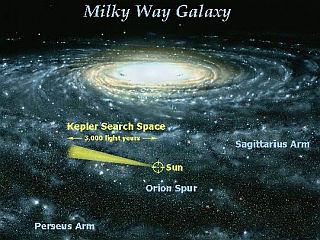 Last evening, we tuned into NASA TV to watch the launch of the Kepler Spacecraft. The countdown procedures went as originally anticipated and the launch was successful.
Last evening, we tuned into NASA TV to watch the launch of the Kepler Spacecraft. The countdown procedures went as originally anticipated and the launch was successful.
Kepler’s mission is to statically observe a patch of our galaxy consisting of roughly one hundred thousand stars. The instrumentation consists of a photometer which will monitor the emissions of the stars to try and detect extra-solar planets. The spacecraft can detect the slight dimming of a star as a planet passes in front of it.
Of course, the orbits of such planets would have to be at an angle where the transit would align with Kepler’s line of sight. I’m hoping that the NASA scientists factor the probability of alignment into their equation to determine the planetary count.
The image above (click to enlarge) is an artist’s rendering of what our galaxy might look as viewed from outside our Galaxy. Our sun is about 25,000 light years from the center of our galaxy. The cone illustrates the neighborhood of our galaxy that the Kepler Mission will search to find habitable planets. Credit: Jon Lomberg.

To give an idea of how large a number a trillion is, I have carefully researched this example.
If your wife caught you in the “act” with another woman, the time needed for you to make a trillion object apologies – each one accompanied by a dozen long stem roses that you had to grow personally – would be long enough for you to clean a kitchen floor that stretched from Earth (Orion Spur) to the Sagittarius Arm.
With your tongue.
Four times.
If that other woman was her sister, thirty times. And only on your knees as both your arms would be hanging out your butt drying the floor.
LOL – Makes my head spin.
However, the concept of groveling after an illicit act never would have occurred to me. You see, Damsel is armed and would blow my brains into the Sagittarius Arm no doubt, should I ever do something like that.
How big is the universe—are we just inside a acorn by the side of a long road, or is it true that we have more stars in the sky than grains of sand on all the beaches of the world. The reality is—we will never know. We can probe and ponder and yet we cannot even say which leaf will fall first on an autumn day.